Buddhist Mountain Monasteries in Korea
Tongdosa Temple
Tongdosa Temple
Introduction
Natural Environment
History
Temple Layout
Cultural Properties
Information
About Tongdosa Temple
-
-
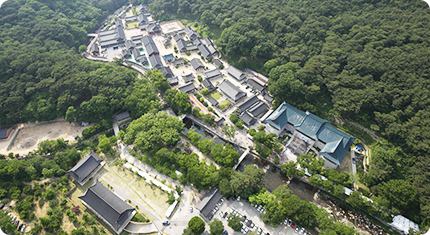 Tongdosa Temple
Tongdosa Temple
-
Situated on Yeongchuksan Mountain in Yangsan-si, Gyeongsangnam-do Province, Tongdosa is the main temple of the 15th diocese of the Jogye Order of Korean Buddhism.
Yeongchuksan, which is also known as Chukseosan, is a rocky mountain. According to Tongdosayakji, it was named after the mountain of the same name (based on the Chinese characters) in India where the Buddha gave the Dharma talk because it resembled its appearance.
Tongdosa was founded by Precepts Master Jajang in 646 (15th year of Queen Seondeok’s reign). According to Tongdosa-sarigasa-sajeok-yannok, the temple site had originally contained a large pond, but it was landfilled and Diamond Stairway (Geumgang-gyedan) was built to found Tongdosa.
-
-
Also, the Samguk-yusa (Legends and History of Korea’s Three Kingdoms) records show that Precepts Master Jajang founded the temple with the enshrinement of some 400 cases containing the sariras, a golden brocade Dharma robe bestowed by the king and the Great Tripitaka (Complete Collection of Buddhist Sutras, Laws, and Treatises) he acquired from Tang Dynasty in 643 (12th year of Queen Seondeok’s reign).
The explanation given for the origin of the name, Tongdosa, is that the “shape of the mountain is consistent with Mount Grdhrakūta (pronounced as Yeongchuksan based on Sino-Korean characters), where the Buddha personally gave the Dharma talks.”
It also has two other meanings: “Those who wish to become monks must pass through this stairway,” and “Master and be proficient in all the truths and save mankind.”
-
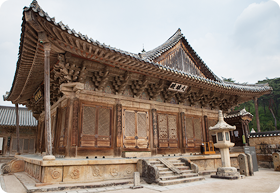 Daeungbojeon of Tongdosa Temple
Daeungbojeon of Tongdosa Temple
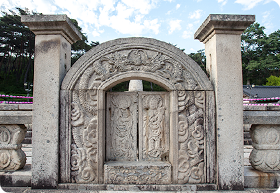 Diamond Stairway of Tongdosa Temple
Diamond Stairway of Tongdosa Temple
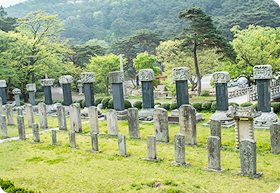 Stupas of Tongdosa Temple
Stupas of Tongdosa Temple
-
- Tongdosa is the first of the Tri-Gem Temples that enshrine the genuine sarira of Sakyamuni Buddha.
Thus, the Daeungjeon Hall of Tongdosa does not contain a separate Buddha image, and instead, the Diamond Stairway was installed to enshrine the genuine sarira of the Buddha that symbolizes Dharmakaya, or Dharma-body.
In the Silla period, it became the bodhi-mandala of Sila and Vinaya, the observances for all Buddhists in the daily life, and gained the status of a head temple. In the Joseon Dynasty, it was considered the foremost temple when a temple for a prayer location was designated by the State. In the Korean Empire period, it was designated as the head temple of Gyeongsangnam-do Province by the government during the designation of 16 head temples in the country. It became the district head temple of Seon and Gyo sects. It gained its status as the first of the Tri-Gem Temples as a result of the enshrinement of the genuine sarira of the Buddha by Precepts Master Jajanag. -
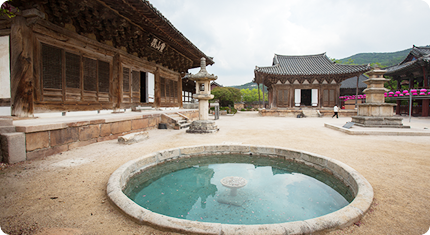 Harojeon of Tongdosa Temple
Harojeon of Tongdosa Temple
- Tongdosa is the first of the Tri-Gem Temples that enshrine the genuine sarira of Sakyamuni Buddha.
Thus, the Daeungjeon Hall of Tongdosa does not contain a separate Buddha image, and instead, the Diamond Stairway was installed to enshrine the genuine sarira of the Buddha that symbolizes Dharmakaya, or Dharma-body.
- There are 17 hermitages at Tongdosa: Gwaneumam, Geungagam, Geumsuam, Banyaam, Baengnyeonam, Baegunam, Botaam, Biroam, Samyeongam, Seounam Seochugam, Sudoam, Anyangam, Ongnyeonam, Jajangam, Chukseoam and Chwiunam.
